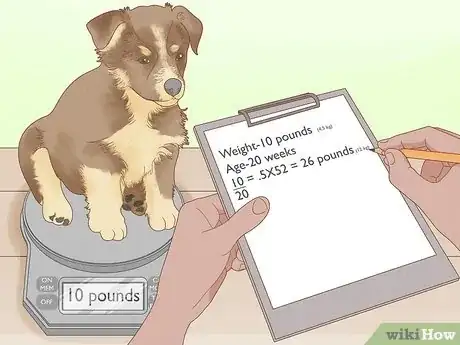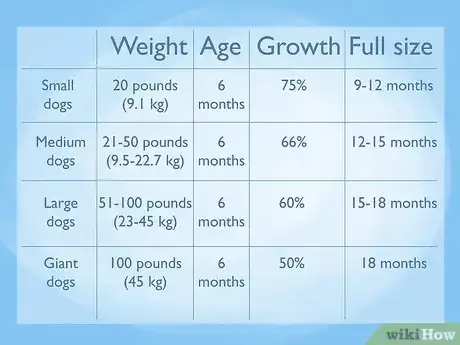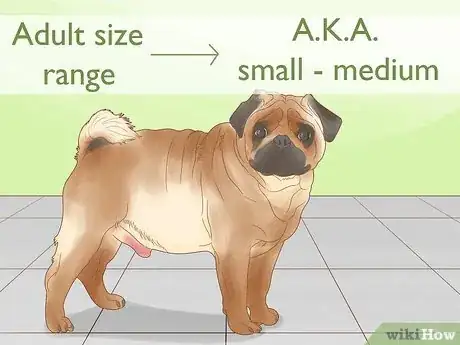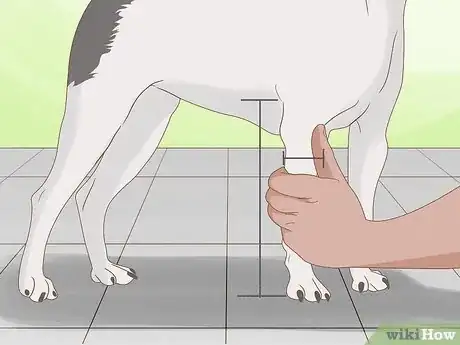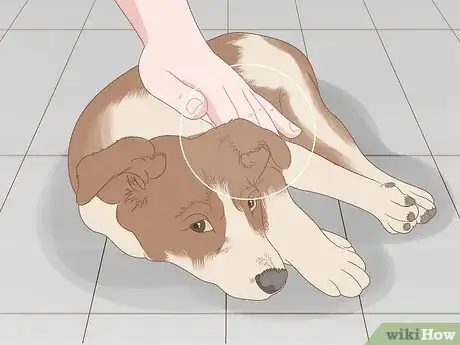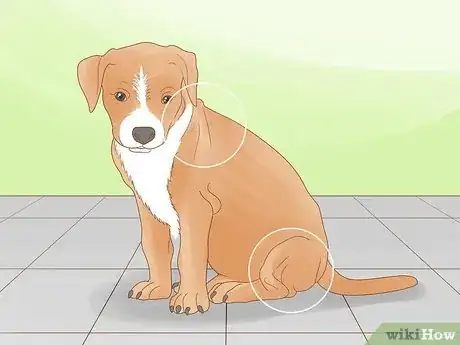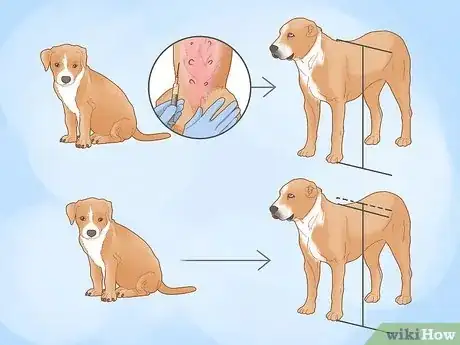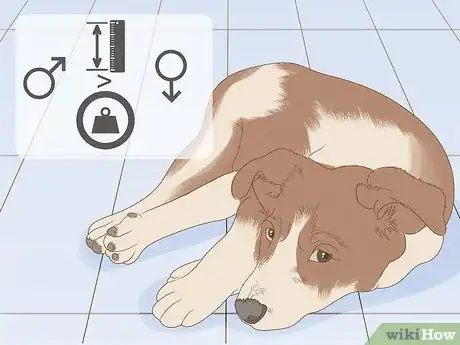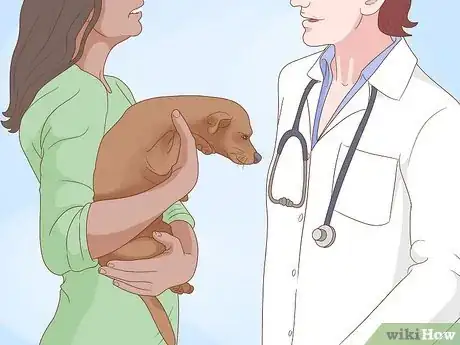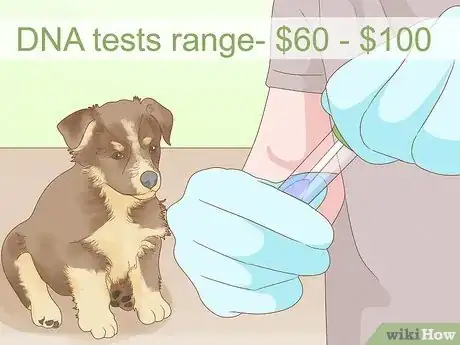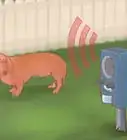This article was co-authored by wikiHow staff writer, Madeleine Criglow. Madeleine Criglow is a wikiHow Staff writer based in the Pacific Northwest. She has over six years of experience working in copywriting, editing, and journalism. In addition to her work for wikiHow, she writes a monthly film column for Tigard Life and Tualatin Life newspaper. Madeleine graduated from the University of Puget Sound with a BA in English with an emphasis in Creative Writing.
This article has been viewed 11,814 times.
Learn more...
Mixed breed puppies are adorable and one-of-a-kind, and there's nothing more exciting than adopting one of your own. If you just adopted a mixed breed pup, you might be curious to know how big they're going to get. Thankfully, there are several ways to predict just that! Read on to learn all the ways you can estimate how big your new puppy is going to get once they reach adulthood.
Steps
Predict your puppy's size by its weight and age in weeks.
-
Find your pup's current weight and age to estimate its size at full-grown. First, weigh your dog. Then, divide their weight by their age in weeks. Multiply that number by 52 (which is the number of weeks in a year). That number will give you a rough estimate of how big your dog will be when they reach adulthood. For example, if your pup weighs 10 pounds (4.5 kg) at 20 weeks, they will be 26 pounds (12 kg) as an adult.
- A puppy growth calculator can do the calculations for you. Search online for a puppy growth calculator, enter your dog's age in weeks and their weight, and find out whether your dog will be small, medium, or large.
- It's important to remember that these calculations are just here to give you an estimate. Some dogs don't reach their adult size until a year and a half or more, so this calculation is not 100% accurate.
Classify your pup by age and size.
-
Use their weight and age to see how much more they have to grow. Dogs are classified into 4 size categories that each grow at a different rate, including small, medium, large, and giant. To guess how big your dog will be, compare their current weight and age to the classifications and stages listed below. For example, small dogs are 75% grown at 6 months. If your dog is 8 months old and 10 pounds (4.5 kg), they'll most likely remain a small dog in adulthood.[1] X Trustworthy Source American Kennel Club The American Kennel Club (AKC) is a purebred dog pedigree registry in the United States. The AKC advocates for the responsible ownership of dogs and promotes purebred dog events, such as the Westminster Dog Show. Go to source
- Small dogs are 20 pounds (9.1 kg) and below. At 6 months, these dogs are 75% grown. They usually reach their full size by 9-12 months.
- Medium dogs are between 21–50 pounds (9.5–22.7 kg). At 6 months, these pups are 66% grown (a little over halfway to their full size). They'll reach their adult size by 12-15 months.
- Large dogs are between 51–100 pounds (23–45 kg). At 6 months, large puppies are 60% grown. They take longer to reach their full size, reaching adulthood between the ages of 15 to 18 months.
- Giant dogs are 100 pounds (45 kg) and above. At 6 months, giant dogs are 50% grown. They'll reach their full size at about 18 months.
Determine your dog's breeds.
-
The larger the breeds, the larger your dog will be as an adult. To estimate your dog's breeds as a mixed pup, examine their physical characteristics, like their muzzle, tail, ears, coat (pattern, color, and texture), and body type.[2] X Research source Then, look up a list of breeds and compare your puppy to their characteristics. Once you find a few promising matches, see how big those breeds typically get to estimate how large your pup will be in adulthood.
- An example of a dog's characteristics would be "short muzzle, curled tail, short and floppy ears, smooth and short coat, tan fur, and muscular build."
- The above example would likely be a pug/bulldog mix, so their adult size would range between the size of a pug and a bulldog (A.K.A. small to medium).
Analyze your dog's paw size.
-
Large paws indicate large dogs. Notice whether your dog's paws are proportionate to their body. If your dog's paws appear too big for their small body, that's an indicator that they'll grow into them and be a large or medium-sized dog in adulthood.[3] X Research source Conversely, if your small pup has proportionate paws, that may be a sign that they're a small dog and won't get quite as big.[4] X Research source
- Though paw size can help you make an estimate, it's important to remember that some dog breeds naturally have large or small paws for their body (even in adulthood). These breeds include collies and bulldogs.
Examine your pup's bone structure.
-
Longer, thicker bones indicate a larger dog. To examine your dog's bone structure, take a look at their legs. If they've got long, hardy legs, that might be a sign that they're going to be a medium or large dog in adulthood. If they've got short, thin legs, that may indicate they'll remain small in adulthood.[5] X Research source
Feel your dog's rib cage.
-
If you feel the knobs of their ribs, your pup is going to get bigger. These knobs are actually your puppy's growth plates. To check for them, put your hand on your dog's ribs and feel for knobs or small lumps at the edge of their rib cage.[6] X Trustworthy Source American Kennel Club The American Kennel Club (AKC) is a purebred dog pedigree registry in the United States. The AKC advocates for the responsible ownership of dogs and promotes purebred dog events, such as the Westminster Dog Show. Go to source
- If you're not sure how to feel for the knobs of your dog's ribcage, ask your vet to do an examination next time you take them in for a checkup.
Take a look at your pup's skin.
-
Saggy skin may indicate that your dog will be large. Loose folds like this suggest that your puppy is still growing into its skin. Though this method can help you see if your pup is still growing, it should be noted that some breeds naturally have loose skin even once they reach adulthood.[7] X Research source
- Dogs like bloodhound mixes and basset hound mixes usually have saggy skin as fully grown adult dogs.
Find out when your puppy was spayed or neutered.
-
Spayed and neutered dogs are slightly taller as adults. A puppy's sex hormones influence how long a puppy keeps growing, as they're partially responsible for stopping the growth process in adulthood. If a puppy is spayed or neutered before they reach adulthood, they won't get the message to stop growing and may grow slightly taller as a result.[8] X Research source
Keep your dog's gender in mind.
Contact the shelter.
-
Find out the parents' breeds to determine how big your pup will get. Though shelters don't always know each dog's family history, asking is worth a shot. Call the shelter or place where you adopted your pup and ask if they knew your dog's parents' specific breed and size. If they do, this will be a good indicator of how large your dog will be as an adult.[9] X Research source
- If they don't know the breed, but know the size, that can still be a good indicator of how big your puppy will get.
Ask your vet for help.
-
A vet can use their expertise to estimate your puppy's adult size. Veterinarians come across all variations of breeds every day, so they can use their knowledge to estimate your mixed breed pup's lineage and future size in adulthood. Next time you bring your pup to the vet for a checkup, ask if your vet can help you predict just how big your puppy will be as a fully-grown adult dog.[10] X Research source
Get a dog DNA test.
-
A DNA test estimates your dog's breed makeup and potential size. By knowing what breeds are in your dog's lineage, you can get a rough idea of how big they'll get as an adult. To get a dog DNA test, look online for a good-quality test and purchase it for delivery to your home. Then, follow the instructions on the test, which usually include taking a swab of your dog's cheek. Then, mail in the sample and await your results.[11] X Research source
- At-home DNA tests range from about $60 to $100.
- To find an accurate, good-quality test, read the reviews of each test online. These can help you determine how satisfied customers were with the results.
You Might Also Like
 How Long Does it Take for Dogs to Get Unstuck After Mating?
How Long Does it Take for Dogs to Get Unstuck After Mating?
 10 Comforting Things to Say (or Text) to a Friend When Their Dog Dies
10 Comforting Things to Say (or Text) to a Friend When Their Dog Dies


 How to Sell Puppies
How to Sell Puppies
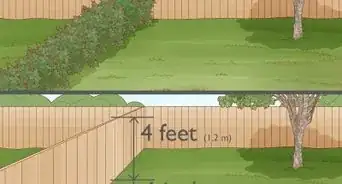 How to Get Dogs to Stop Eating Rabbit Poop
How to Get Dogs to Stop Eating Rabbit Poop
 12 Common Reasons Why Dogs Put Their Ears Back
12 Common Reasons Why Dogs Put Their Ears Back
 How to Clean Dog Pee from a Mattress
How to Clean Dog Pee from a Mattress





References
- ↑ https://www.akc.org/expert-advice/health/when-does-my-puppy-finish-growing/
- ↑ https://www.americanscientist.org/article/genetics-and-the-shape-of-dogs
- ↑ https://enduraflap.com/blogs/pet-doors/how-big-your-puppy-will-be-by-his-paws
- ↑ https://dogfoodsmart.com/puppy-growth-chart/
- ↑ https://www.animalwised.com/at-what-age-do-dogs-stop-growing-3243.html
- ↑ https://www.akc.org/expert-advice/health/when-does-my-puppy-finish-growing/
- ↑ https://enduraflap.com/blogs/pet-doors/how-big-your-puppy-will-be-by-his-paws
- ↑ https://dogfoodsmart.com/puppy-growth-chart/
- ↑ https://www.animalwised.com/at-what-age-do-dogs-stop-growing-3243.html
About This Article

